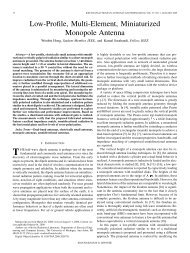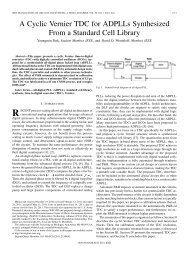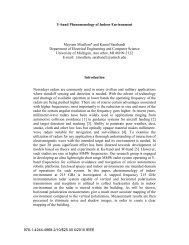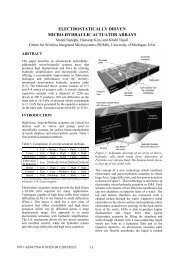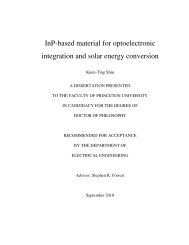A 14 mW Fractional-N PLL Modulator With a Digital ... - IEEE Xplore
A 14 mW Fractional-N PLL Modulator With a Digital ... - IEEE Xplore
A 14 mW Fractional-N PLL Modulator With a Digital ... - IEEE Xplore
You also want an ePaper? Increase the reach of your titles
YUMPU automatically turns print PDFs into web optimized ePapers that Google loves.
FERRISS AND FLYNN: A <strong>14</strong> <strong>mW</strong> FRACTIONAL-N <strong>PLL</strong> MODULATOR WITH A DIGITAL PHASE DETECTOR AND FREQUENCY SWITCHING SCHEME 2467<br />
Fig. 6. Small-signal phase domain model will noise sources.<br />
Fig. 7. (a) Simplified model for inner loop. (b) Simplified model for both loops.<br />
Similarly, for the output loop, , the closed-loop and<br />
open-loop responses are given in (3) and (4), respectively:<br />
(3)<br />
If the higher order poles, , are ignored, then we can<br />
combine (1),(2),(3) and (4) to give the overall closed-loop response<br />
(5):<br />
(4)<br />
(5)<br />
We note that this is an all pole system; there are no zeros.<br />
(Dual loop architectures have also been used in fiber optic communication<br />
<strong>PLL</strong>s to implement transfer function with no zeros<br />
[16].)<br />
In Fig. 7(a) the loop is redrawn with the inner loop, ,<br />
replaced with its equivalent transfer function. Here the only inputs<br />
considered are the reference, the frequency control word<br />
and noise. In Fig. 7(b) the outer loop, , is also replaced.<br />
From this it is straightforward to deduce the transfer<br />
functions from input to output. The relationship between the<br />
reference phase and output phase is given in (6). ( is first<br />
multiplied by , to convert it to an approximate equivalent continuous<br />
time source.)<br />
(6)<br />
Fig. 8. Plot of measured and calculated noise sources.<br />
In a similar manner, the transfer function for all of the noise<br />
sources can be calculated. The various noise sources, and the<br />
total calculated noise, and measured noise are plotted in Fig. 8.<br />
For low and very high frequencies the phase noise is dominated<br />
by the VCO noise, while for frequencies close to the loop bandwidth<br />
(<strong>14</strong>2 kHz) the phase detector quantization noise (PD noise<br />
in Fig. 8) is significant. The poor VCO phase noise performance<br />
is due in part to the low quality factor of available integrated inductors<br />
on this process. The divider noise does not make a<br />
significant contribution to the output phase noise. This is because<br />
the reference clock used is large in comparison to the<br />
loop bandwidth, and hence most of the quantization noise<br />
is shaped to outside of the <strong>PLL</strong> loop bandwidth.<br />
Both of the two <strong>PLL</strong> loops contain a single net integrator, and<br />
therefore each loop is a Type 1 loop. This may seem surprising



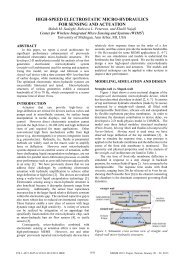
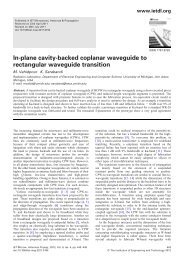
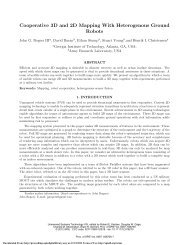
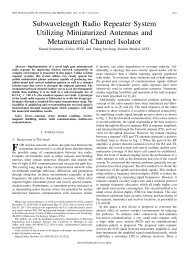
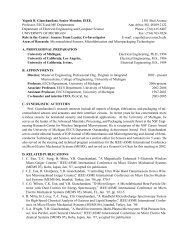
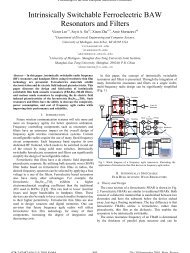
![[Sample B: Approval/Signature Sheet]](https://img.yumpu.com/34084789/1/190x245/sample-b-approval-signature-sheet.jpg?quality=85)

